Autism And The Benefits Of Structured Music Lessons
Exploring the Power of Structured Musical Education for Autism Support
Structured music lessons can serve as a potent tool to support the multifaceted development of children with autism spectrum disorder (ASD). By providing predictable, multisensory learning environments, these lessons foster communication, social skills, emotional regulation, and cognitive growth. This article delves into how structured musical activities and therapy integrate seamlessly into developmental interventions, supported by scientific evidence and best practices, to promote well-being and independence in autistic children.
The Significance of Structure in Autism Interventions
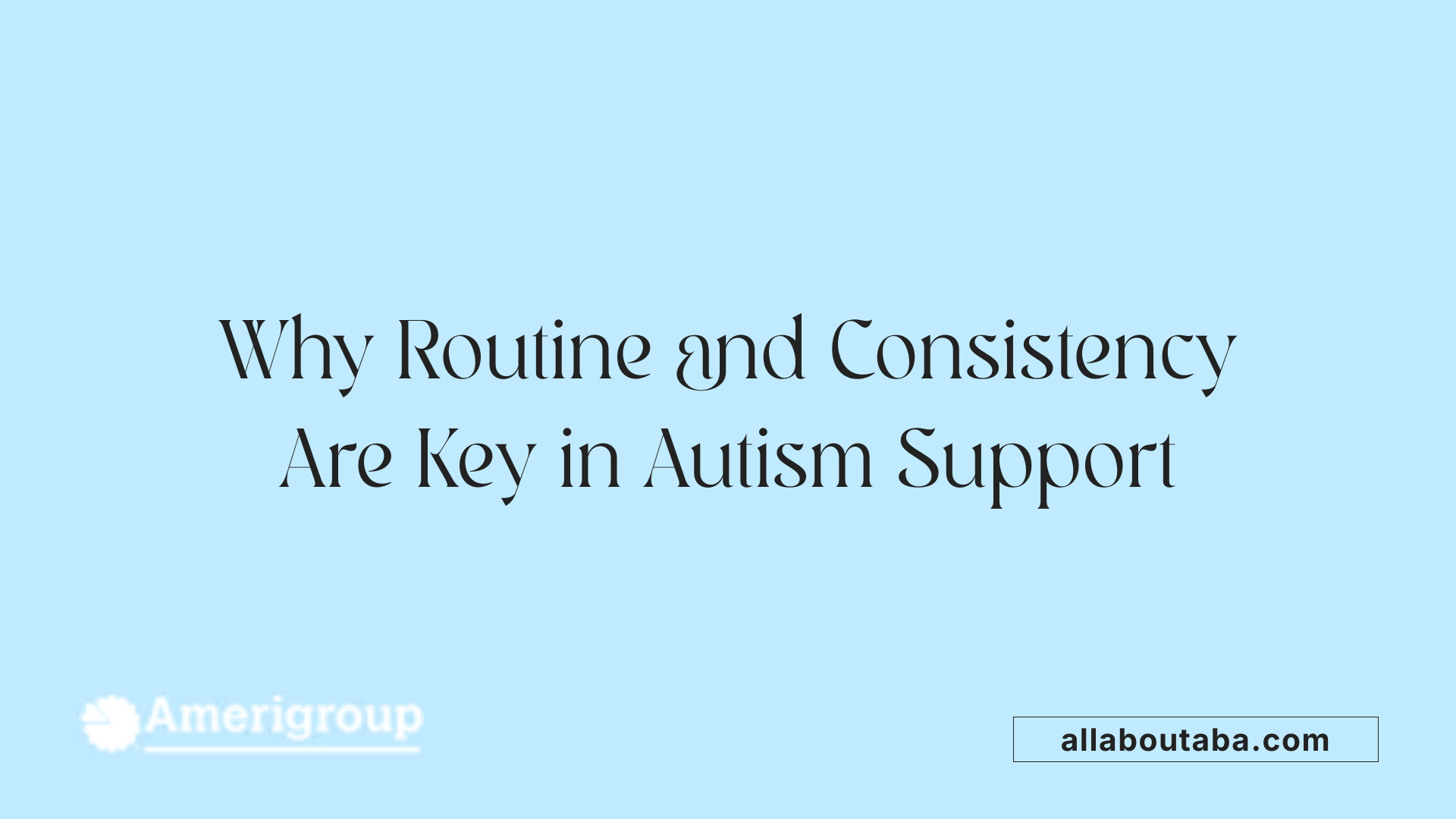
Why is structure important for children with autism?
Structure plays a vital role in supporting children with autism because it offers predictability and stability within their environment. These qualities are crucial as they help reduce feelings of uncertainty, anxiety, and stress, which are common in children with ASD.
Establishing routines allows children to anticipate upcoming activities and transitions, leading to decreased behavioral challenges and increased comfort. When routines are consistent, children develop a sense of control over their daily experiences, fostering confidence and independence.
In addition, visual supports, such as picture schedules or visual cues, make routines more accessible by providing clear, concrete representations of what to expect. This not only aids understanding but also actively involves children in creating and following routines, promoting engagement.
Consistency across environments—home, school, and therapy settings—ensures children experience a familiar structure, which assists their emotional regulation and adaptation. Regular routines also facilitate the development of important life skills including communication, self-care, and social interactions.
Smooth transitions between activities are enhanced by predictable patterns, helping children manage change without distress. Overall, structured routines help children with autism navigate daily life more comfortably, supporting their well-being and ongoing developmental progress.
Structured Music Lessons: A Tailored Approach for Autism
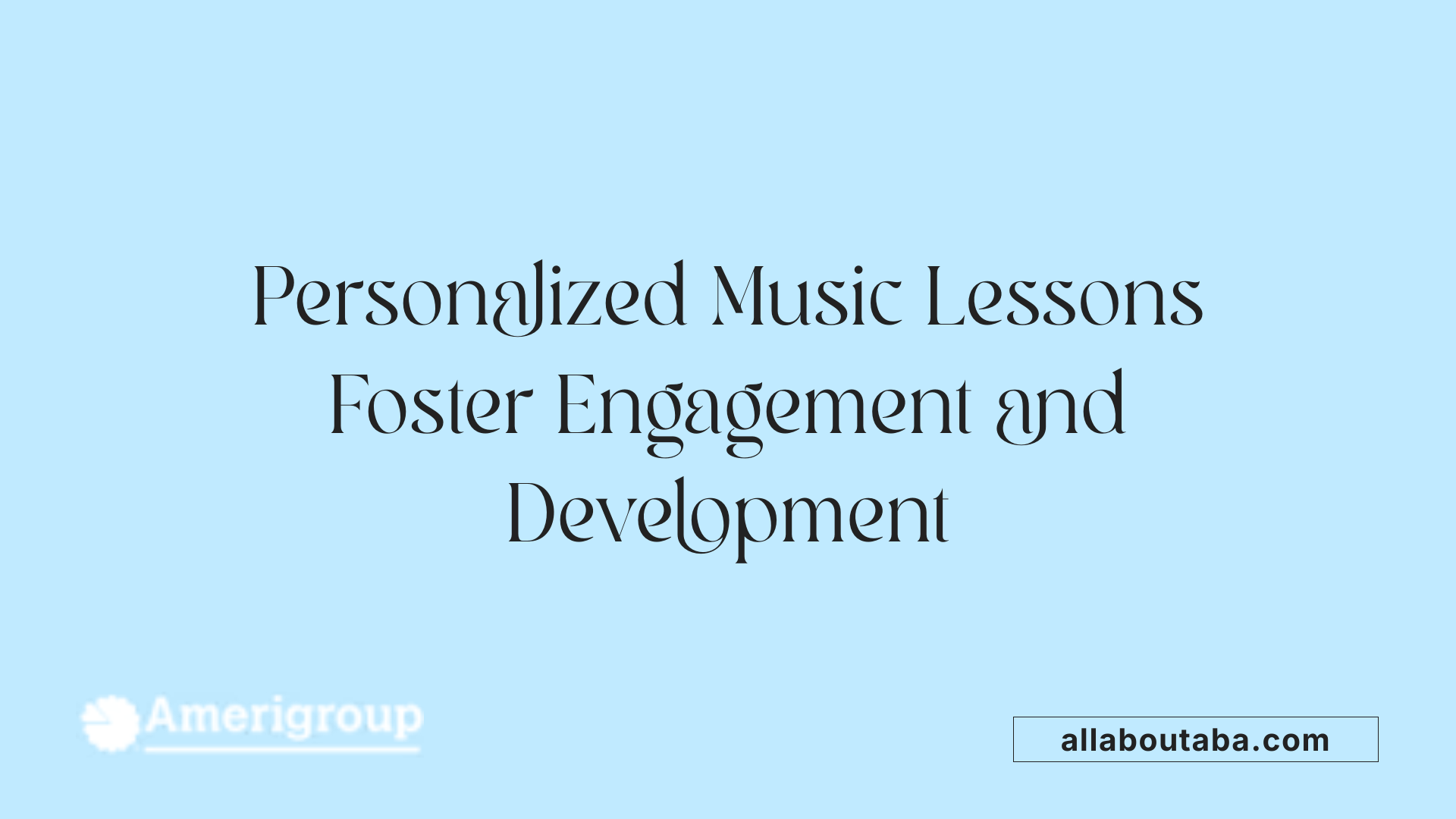
What are the benefits of structured music lessons for children with autism?
Structured music lessons provide numerous advantages for children on the autism spectrum. They significantly support communication, social interaction, emotional regulation, and cognitive growth. Music naturally activates both hemispheres of the brain, creating pathways that boost language development, attention, and sensory integration.
Group musical activities encourage turn-taking, sharing, and cooperation, which are crucial for building social skills. These activities foster a sense of community and belonging, helping children to connect more easily with peers.
A core feature of effective music education for autistic children is personalization. Teachers tailor lessons to each child's interests and sensory sensitivities, making learning more engaging and less overwhelming. For example, using favorite instruments or styles of music can increase motivation and comfort.
Overall, structured music interventions are evidence-based and adaptable, making them powerful tools for nurturing developmental progress and emotional well-being in children with autism.
Music Therapy: Neurodevelopmental Support through Musical Engagement
How does music therapy support development in children with autism?
Music therapy offers a supportive approach to help children with autism develop essential skills across multiple domains. It involves personalized, music-centered activities designed to address communication, social interaction, emotional regulation, and cognitive growth. These interventions often include singing, instrument playing, and improvisation, tailored specifically to each child's unique needs and administered by trained music therapists.
One of the core mechanisms behind the effectiveness of music therapy is sensorimotor integration. This process involves the synchronization of sensory inputs with motor responses, enhancing the child's ability to process sensory information and respond accordingly. Through rhythmic activities, instrument play, and movement, children learn to coordinate their sensory and motor systems, which improves their overall functioning.
Music therapy also promotes cortical modulation, meaning it helps regulate and strengthen neural pathways in the brain. As a result, areas involved in language, social processing, and emotional regulation become more connected and efficient. For example, engaging with musical activities activates multiple brain regions, including auditory, motor, and limbic systems, fostering neuroplasticity and boosting overall brain connectivity.
Research indicates that these neural enhancements translate into tangible behavioral benefits. Children participating in music therapy often show improvements in social skills, such as turn-taking, sharing, and eye contact. Language development also benefits, with increases in verbalization, vocabulary, and sentence formation. Moreover, music's calming and predictable nature helps reduce anxiety and stress, creating an environment conducive to learning and emotional expression.
Music therapy employs varied techniques, including singing, instrument playing, and improvisation, which target different developmental facets. Songs and musical storytelling can help in developing verbal skills, while group activities encourage social engagement and teamwork. By stimulating multiple brain areas simultaneously, music therapy not only supports immediate behavioral goals but also contributes to longer-term neural and developmental gains.
Overall, music therapy is a dynamic, evidence-based intervention that fosters neuroplasticity, emotional well-being, and social connection, making it a valuable tool in supporting children with autism's growth and development.
Scientific Evidence Validating the Role of Music in Autism Interventions
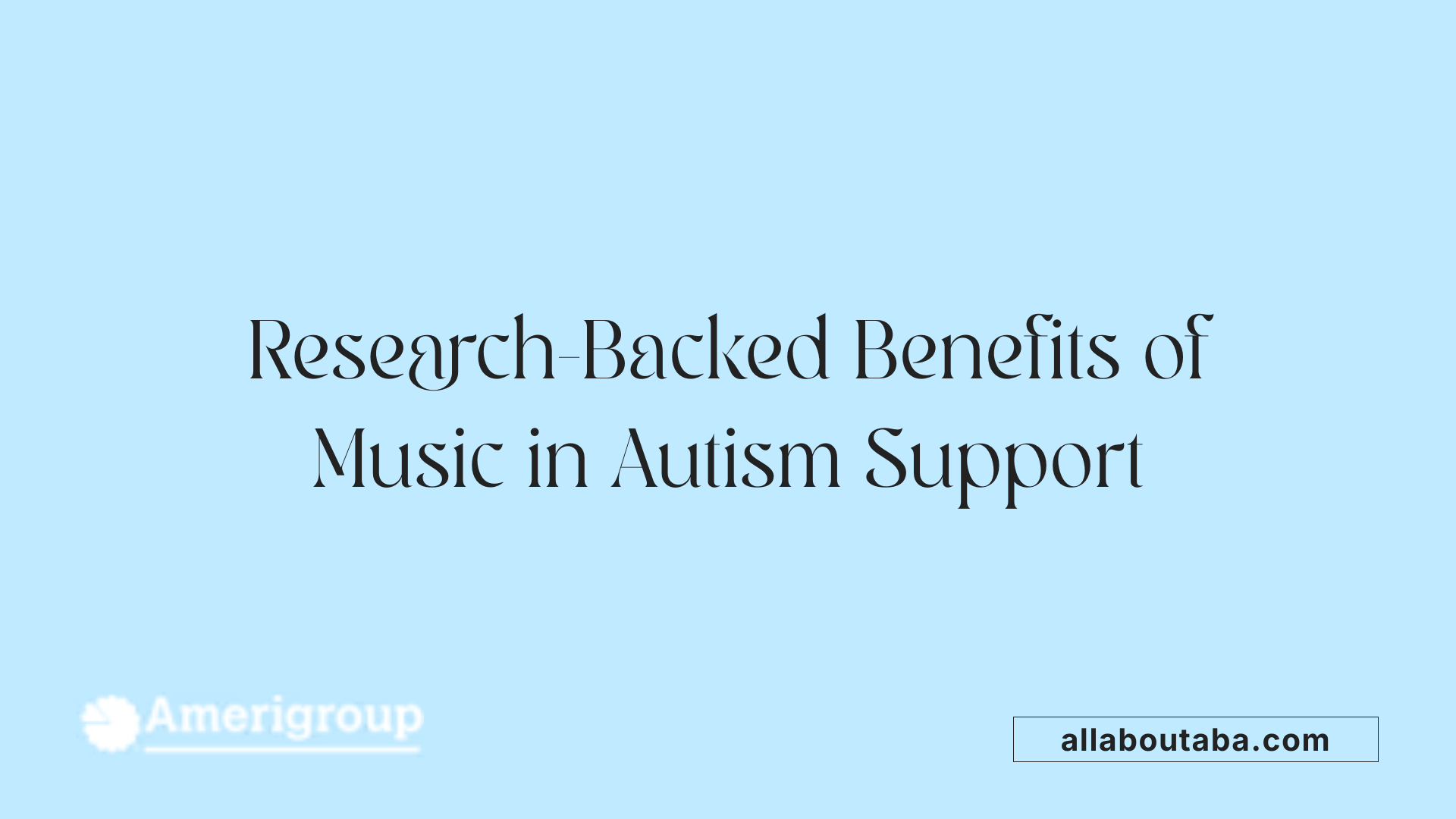
What is the scientific evidence supporting music as an effective intervention for autism?
Accumulative research provides strong support for using music therapy as an effective approach to help children with autism spectrum disorder (ASD). Various scientific studies, including meta-analyses and randomized controlled trials, reveal that music therapy can significantly improve core outcomes like social interaction, communication, and emotional regulation.
Meta-analyses focusing on these trials have shown that children with autism who participate in music therapy exhibit a modest but meaningful enhancement in social reactions, with standardized mean differences (SMD) around 0.24. More prominently, they demonstrate notable gains in social skills, such as initiating interactions, sharing, and understanding social cues. Effect sizes in these areas range from moderate to large, indicating substantial developmental benefits.
Beyond social behaviors, music therapy also enhances communication abilities. Improvements are observed in both verbal and non-verbal skills, often exceeding results seen with placebo or conventional treatments. This includes better vocalization, vocabulary, and the ability to interpret social-emotional cues. Additionally, secondary benefits—like increased happiness, participation, and strengthened relationships—are frequently reported.
While some specific outcomes such as reduction in core autism symptoms or speech improvements show mixed results, overall evidence underscores music therapy’s multifaceted positive influence. It supplements traditional treatment modalities and promotes overall well-being.
Despite these promising findings, current research faces limitations. Many studies have small sample sizes and variable methodologies, which challenge the generalization of results. Moreover, there is a need for longer-term studies to assess whether these improvements are sustained over time and how they translate into everyday functioning.
In conclusion, scientific evidence strongly supports music therapy as a valuable tool in autism intervention, especially for enhancing social and communicative functioning. Ongoing research aims to optimize these interventions and establish long-lasting benefits for individuals with ASD.
Impact of Music Education on Emotional, Social, and Cognitive Development
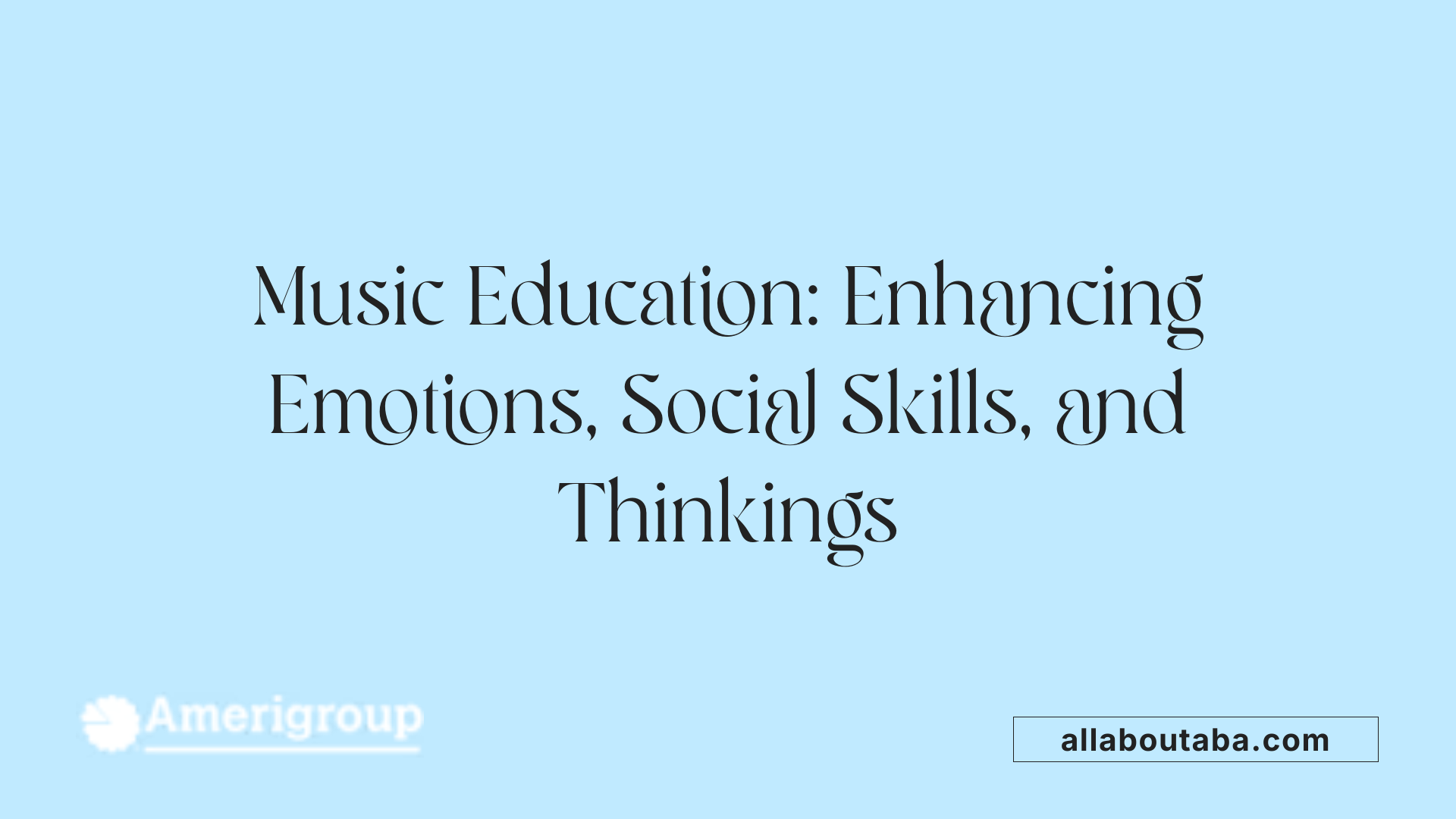
How does music education impact emotional regulation, social skills, and cognitive development in individuals with autism?
Music education plays a vital role in supporting the overall development of children and individuals with autism. One of its primary benefits is enhancing emotional regulation. Musical activities, such as singing, rhythmic exercises, and improvisation, provide safe outlets for expressing feelings, which helps individuals recognize and manage their emotions more effectively. Music's calming and predictable nature often reduces anxiety and stress, making it easier for children to regulate their mood.
In addition to emotional benefits, music education fosters social bonding. Group activities like ensemble playing, singing, and collaborative musical projects encourage turn-taking, sharing, and social interaction. These experiences promote communication skills, empathy, and cooperation, strengthening interpersonal relationships. Music provides a common platform where children can connect, encouraging participation without the demands of traditional social settings.
Cognitive development is also significantly supported through engagement with music. Playing instruments and structured musical activities activate multiple brain areas, leading to improved neural connectivity. These activities enhance attention span, working memory, and problem-solving skills. Research shows that music interventions can support language development, vocabulary, and even executive functioning, such as planning and sequencing.
Furthermore, music-based approaches support physical coordination and motor skills through instrument handling, dancing, and movement activities. This holistic stimulation nurtures overall physical development while reinforcing cognitive and emotional growth. Armed with visual cues, structured routines, and personalized lessons, music education offers a flexible, multisensory method that responds to the unique needs of autistic individuals.
In summary, music education provides a comprehensive framework that nurtures emotional stability, promotes meaningful social interactions, and advances cognitive skills essential for daily life and integration. Its adaptability makes it a valuable component of multidisciplinary intervention strategies, fostering growth in all developmental domains for those with autism.
Therapeutic Advantages of Music and Movement Interventions
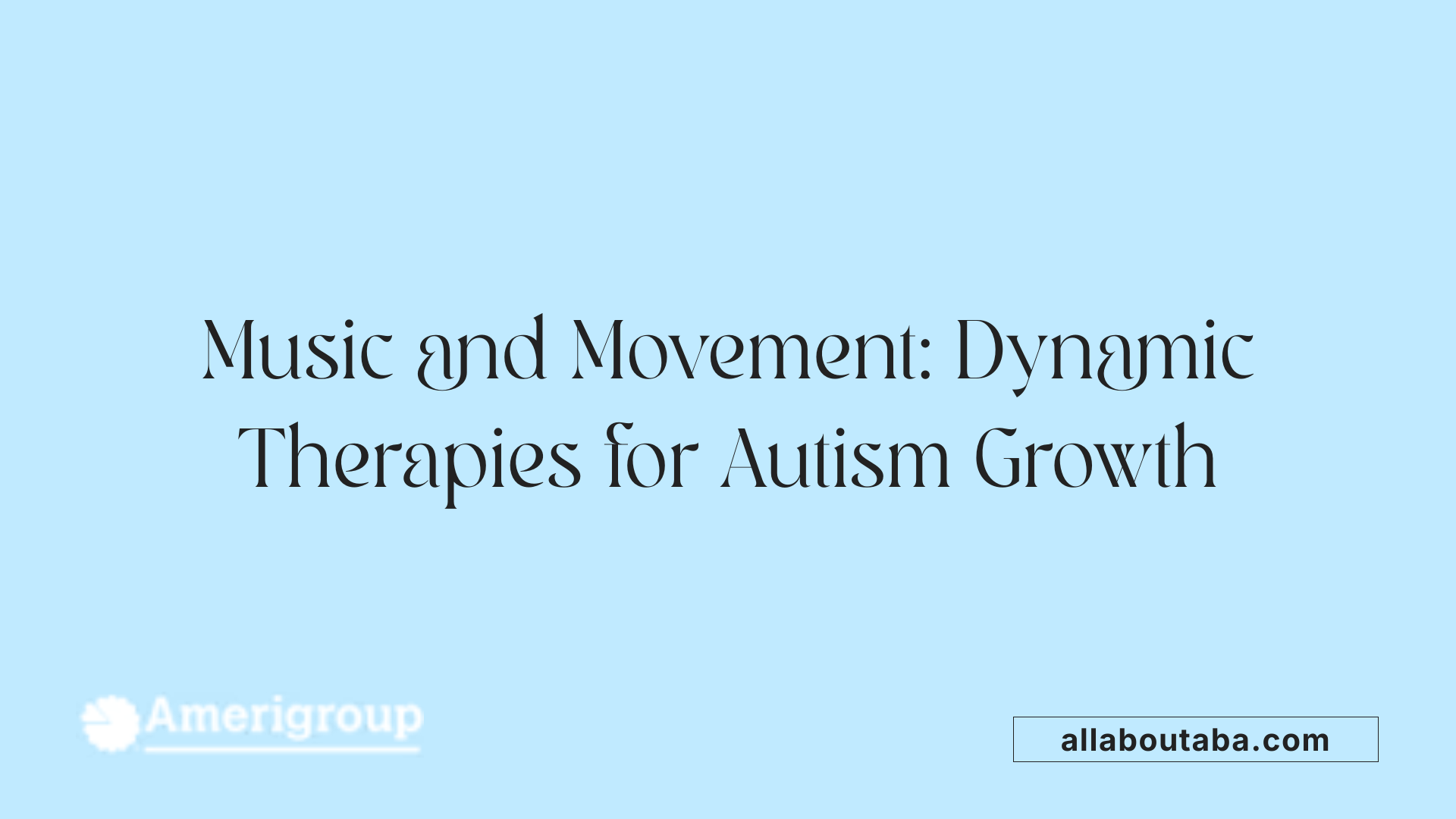
What therapeutic advantages does music and movement therapy offer for children with autism?
Music and movement therapies are highly beneficial for children with autism, supporting various aspects of their development and well-being. These approaches focus on enhancing social skills, emotional regulation, communication, and motor coordination.
One of the primary benefits is fostering social engagement. Through activities like turn-taking, group singing, and mirroring movements, children learn to interpret social cues, develop relationships, and improve peer interaction. These structured interactions help children understand nonverbal communication, such as facial expressions and gestures, which are often challenging for them.
Emotional regulation is another significant advantage. Musical activities provide a safe, calming environment where children can explore and express their feelings. Rhythmic exercises, improvisation, and musical storytelling help reduce anxiety and stress, aiding in emotional self-regulation.
Further, music and movement stimulate brain development by activating multiple neural pathways. This can lead to improvements in sensory integration and cognitive skills like attention, memory, and pattern recognition. For example, engaging with rhythmic patterns enhances timing and coordination, which are crucial for movement and daily activities.
Motor skills, including both fine and gross coordination, are also supported through activities such as instrument playing, dancing, and rhythmic exercises. These activities improve hand-eye coordination, bilateral motor integration, and overall physical stability.
Additionally, using improvisation and movement encourages creativity and spontaneous responses, helping children develop flexible thinking and problem-solving abilities.
In summary, music and movement therapies offer enjoyable, evidence-based tools to address core challenges faced by children with autism. They can be incorporated into daily routines, promoting social interaction, emotional health, motor development, and cognitive growth—contributing to improved quality of life and greater independence.
Empowering Development Through Music
Structured music lessons and therapy offer a multidimensional approach to supporting children with autism. They leverage the brain’s plasticity and multisensory engagement to enhance communication, social interaction, emotional stability, and cognitive skills. Evidence from scientific research underscores the effectiveness of these interventions, advocating for their integration into comprehensive autism support plans. By providing predictable, engaging, and individualized musical experiences, caregivers and educators can significantly improve the quality of life and developmental trajectory of children with autism, fostering confidence, independence, and social inclusion.
References
- Explore How Music Lessons Benefit Autistic Children - Music Pandit
- 4 Reasons Music Is a Powerful Tool for Autistic Children
- Using music to assist language learning in autistic children with ...
- The Benefits of Music Therapy for Young Kids With Autism
- 7 Reasons Music Lessons are Beneficial for kids with Autism
- A Systematic Review of Scientific Studies on the Effects of Music in ...
- Making Music Education Accessible for Students with Autism ...
- Music therapy and autism: how it can help people with ASD
- Striking a Chord: The Benefits of Playing Music for Autistic Individuals
Other articles
Recent articles

Best Practices For Autism-Friendly Fitness And Recreation Centers

Best Ways To Promote Healthy Social Media Use For Autistic Teens

How To Help Autistic Children Cope With Public Speaking

Autism And Strategies For Managing Unexpected Changes

Best Podcasts About Autism For Parents And Educators

Autism And The Impact Of Seasonal Changes On Behavior

The Role Of Diet In Managing Co-Occurring Conditions With Autism

Sleep Challenges In Autism And Practical Solutions

Best Ways To Build Daily Routines For Autistic Children

Best Practices For Supporting Autistic Entrepreneurs

Autism And Strategies For Navigating Large Social Gatherings

Adaptive Sports And Recreational Activities For People With Autism

Autism And The Benefits Of Story-Based Learning Activities

Understanding The Role Of Play In Autism Development

Autism And The Impact Of Environmental Noise On Learning

How To Create Autism-Friendly Community Spaces

Autism And Chronic Health Conditions: What To Know

The Role Of Care Managers In Autism Life Planning

How To Teach Social Boundaries To Autistic Children

How Autistic Individuals Experience Empathy Differently

How To Support Autistic Employees In Remote Work Settings

Autism And The Relationship Between Motor Skills And Learning

How To Create Community Resource Guides For Autism Families

How To Teach Daily Living Skills To Autistic Teens

Autism And The Impact Of Mind-Body Practices On Stress Reduction

Autism And The Benefits Of Outdoor Group Activities

How To Create Autism-Friendly Sensory Paths In Schools

Best Practices For Autism-Friendly Park And Recreation Areas

Autism And Strategies For Reducing School Refusal

Supporting Autistic Individuals In Public Speaking

The Role Of Diet In Managing Autism Symptoms

The Benefits Of Gardening Clubs For Autism Social Development

How To Prepare Autistic Children For Dental Visits

Autism And Employment: Career Paths That Work

Best Practices For Autism-Friendly Hotels And Lodging

The Impact Of Screen Time On Autism Development

Autism Screening Tools For Early Childhood

The Role Of Physical Exercise In Autism Therapy

Best Strategies For Supporting Autistic College Students

The Role Of Technology In Autism Early Detection

Sensory-Friendly Classroom Design Ideas For Autistic Students

The Role Of Speech Therapy In Building Social Communication Skills

Best Strategies For Handling Autistic Burnout In Adults

Autism And The Importance Of Predictability In Routine

Autism And Peer Education: Teaching Acceptance In Schools

Best Practices For Sensory-Friendly Libraries And Reading Rooms

Self-Advocacy Skills For Autistic Adults

The Role Of Technology In Autism Peer Communication

Promoting Physical Activity In Children With Autism

How To Prepare Autistic Children For Medical Procedures

The Role Of Social Media In Autism Advocacy And Awareness

The Impact Of Sensory Rooms In Public Facilities For Autism

How To Create An Autism-Friendly Holiday Celebration

Best Practices For Inclusive Education For Autistic Students

Autism And Mental Health: Recognizing Signs Of Distress

Best Practices For Sensory-Friendly Waiting Rooms

The Role Of Teachers In Early Autism Red Flag Identification

Autism-Friendly Housing Design Features

Autism-Friendly Housing Design Features

How Environmental Modifications Improve Autism Outcomes

Autism And Technology-Based Learning Tools

Supporting Autistic Children Through Changes In Routine

The Link Between Autism And Working Memory Challenges

Best Practices For Autism-Friendly Cooking Classes

Autism And The Benefits Of Structured Music Lessons

Best Books To Teach Kids About Autism Acceptance

Sensory Diets And Their Benefits For Autism Management

How To Prepare Autistic Teens For Driver’s Education

How To Teach Autistic Teens About Healthy Relationships

The Role Of Visual Prompts In Building Daily Habits For Autism

Addressing Sleep Regression In Children With Autism

Understanding Social Stories And How They Help Autistic Children

Navigating Insurance Coverage For Autism Therapy Services

How To Prepare Autistic Adults For Independent Travel

Supporting Autistic Individuals In Volunteer Work

How Mindfulness Practices Can Support Autism Well-Being

Understanding Hyperfocus And Special Interests In Autism

Understanding Stimming As A Self-Regulation Tool

Sensory-Based Interventions For Autism At Home

Best Ways To Introduce Self-Advocacy In Autistic Teens

Best Ways To Support Autistic Employees In Customer Service Roles

Best Practices For Autism-Friendly Volunteer Programs

Autism And The Benefits Of Sensory Play For Emotional Growth

Autism And Strategies For Building Peer Relationships

Understanding How Autism Affects Memory Processing

Autism And Strategies For Building Coping Skills In Teens

The Role Of Parent Training In Autism Intervention Programs

Autism-Friendly Workplace Accommodations

Using Visual Timers For Autism Time Management

What Is ABA Therapy?

Autism and Sleep

Do Plastic Toys Cause Autism?

Autism Facial Expressions

Autism and Motor Skills

Which Parent Carries The Autism Gene?

Autism Symbols & Colors

Rett Syndrome: Symptoms, Causes, and Treatment

Self-Diagnosed Autism

Autism and Sound Sensitivity

Autism With Speech Delay
We’re All About You, Your Family, and Your Child

